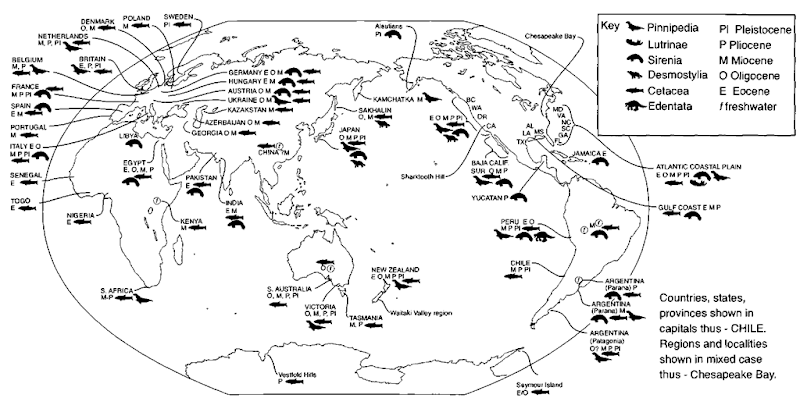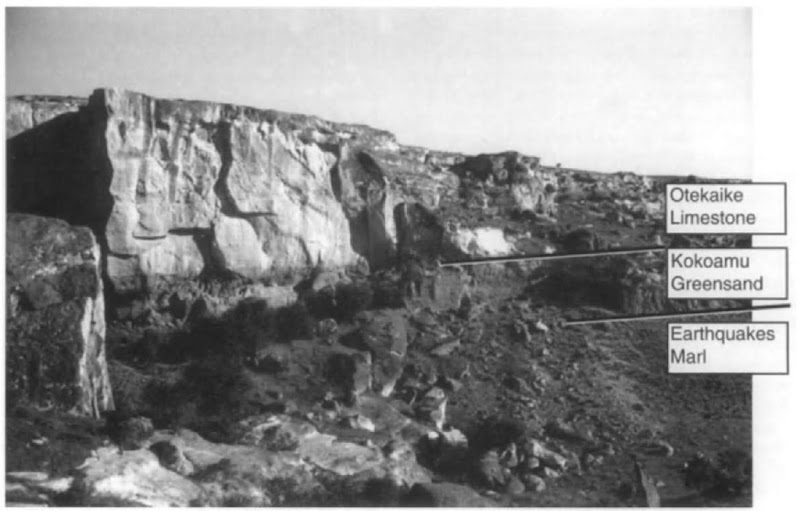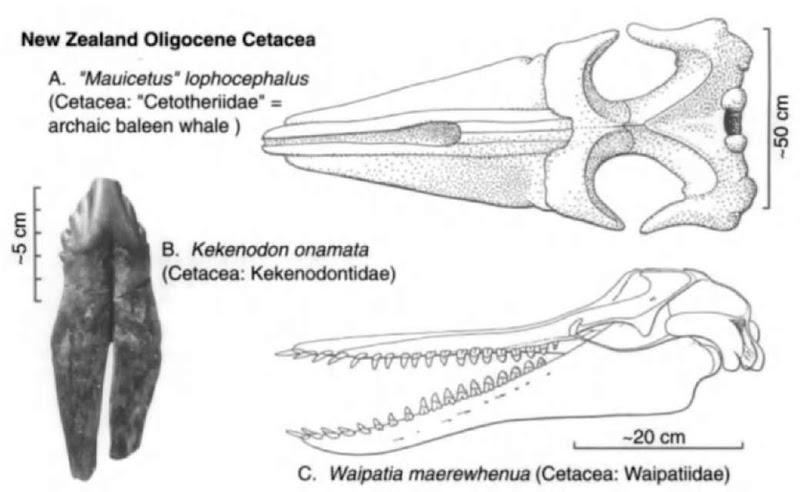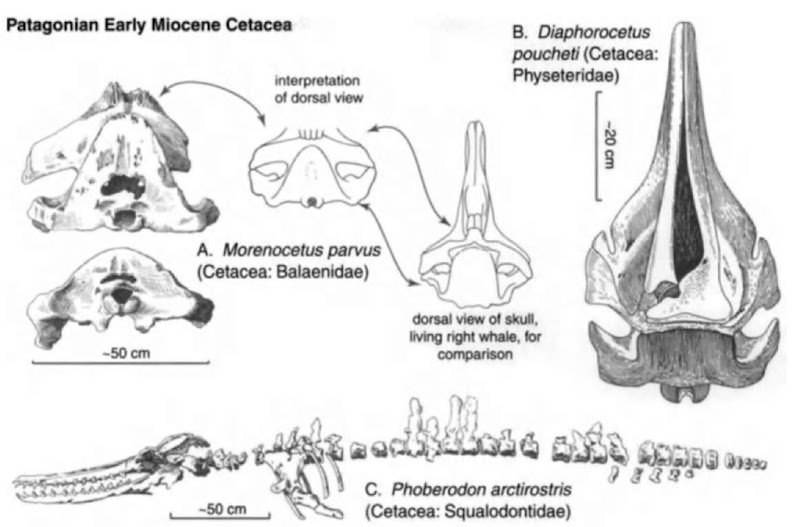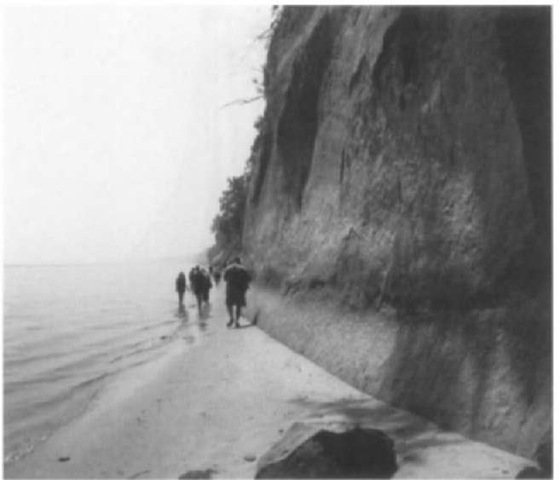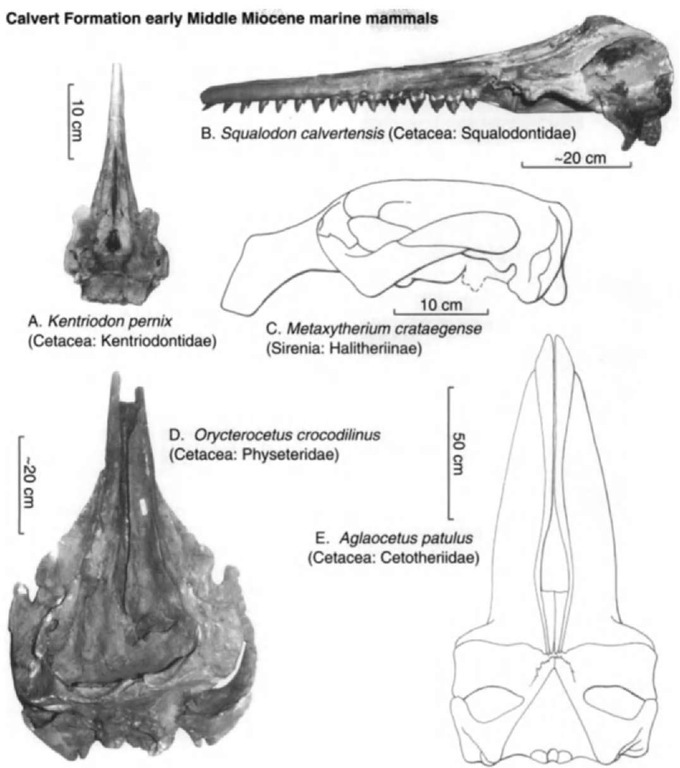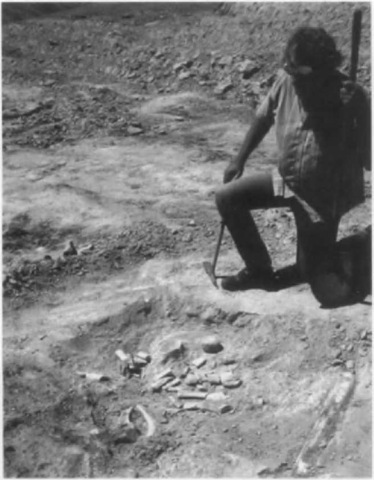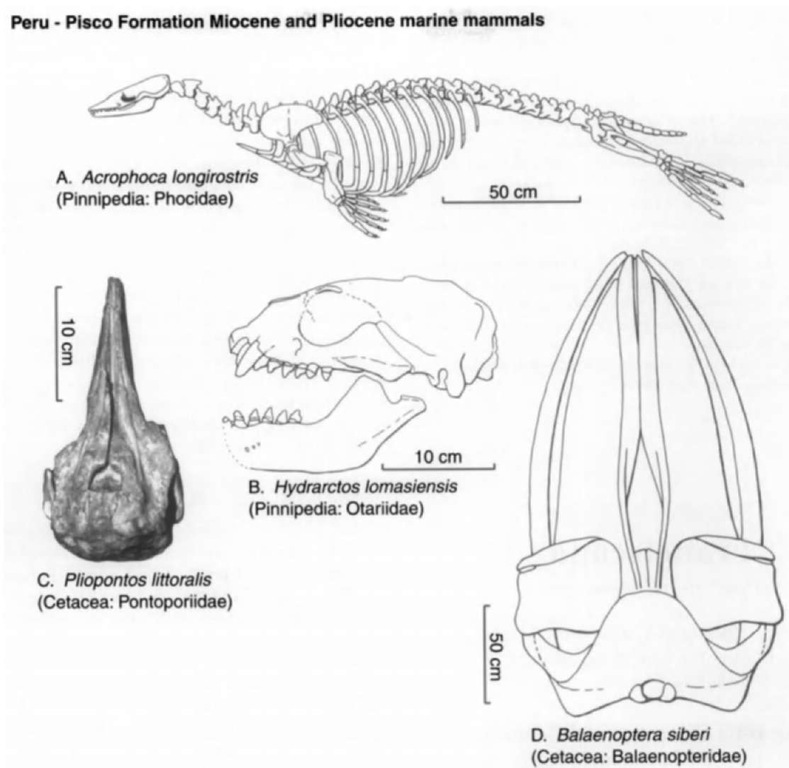Fossil marine mammals—Cetacea, Sirenia, Desmostylia, Pinnipedia, and other aquatic carnivores—are known from hundreds of sites worldwide (Fig. 1). In the 1800s most localities were in temperate northern latitudes, but since 1900 finds have spanned from modern tropics to poles, in both north and south and on all major continents. Usually, sites preserve marine sedimentary rocks, which have been exposed on land through sea-level fall and/or uplift, followed by erosion. There are negligible records (dredgings) from the deep ocean, but there are some important freshwater sites for secondarily nonmarine species. Clearly, fossils give only a rough and indirect guide to former distributions in ancient oceans. Sites vary from rich localized concentrations at sites a few tens of meters across, to scattered occurrences across many kilometers, which become significant at the regional level, and they range in age from Eocene to Pleistocene (Fig. 2). The case studies in this article, given in sequence from oldest to youngest, span all the major time intervals and oceans.
I. Role of Geological Processes
Marine mammal history has been affected by geological changes in oceans and climates during the last 50+ million (M) years. These changes ultimately reflect global tectonic processes. Continents are now relatively more emergent than for much of the past 50 M years, with less continental shelf and less extensive shallow continental sea than in the past. Most continents preserve coast-parallel strips of ancient marine rock now exposed on land. These may be extensive and a notable source of cetacean fossils (e.g.. the Atlantic Coastal Plain of the eastern United States) or limited (e.g.. most of Africa). Sometimes extensive shallow epicontinental seas onlapped the continents, as in northern Europe and the Paratethys (see later). Major drops in sea level occurred about 30 million years before the present (Ma) and, associated with widespread glaciation and global cooling, since 2 Ma (major fluctuations).
Figure 1 Selected localities for fossil marine mammals.
Figure 2 Geological age ranges for key localities for fossil marine mammals, as discussed under case studies.
When the first marine mammals appeared, the extensive shallow Tethys Sea stretched from the Pacific to about the modem Mediterranean. By the end of the Eocene, India had moved northward to collide with Asia, closing much of the Tethys. More western remnants of the Tethys, through what is now southern Eurasia, were eliminated in the Miocene, when Africa collided with Eurasia. Later, the Mediterranean dried out completely about 6 Ma, with dramatic consequences for the biota.
In the south, Australia moved north away from Antarctica opening part of the Southern Ocean by the end of Eocene time (34 Ma). Later, Antarctica and South America separated in the Oligocene (>23 Ma) to open the Drake Passage, which allowed the west to east flow of a newly developed Circum-Antarctic Current. This current isolated Antarctica thermally and probably allowed the Antarctic ice cap to expand, global climates to cool, and global oceans to become more heterogeneous. Australia continued to drift north, so that in about Middle Miocene (~15 Ma) it closed the Indopacific seaway between Australia and Asia and restricted equatorial circulation between the Indian and the Pacific Oceans. In the middle Pliocene (~3-4 Ma), the Panama Seaway closed, cutting Caribbean-Pacific links. The closure of the Panama Seaway correlates closely with the start of Northern Hemisphere continental glaciation.
II. Global Summary of Localities
Important localities occur in marine sequences around the modem Mediterranean, which is a remnant of the formerly extensive Tethys sea and the now-vanished Paratethys. Cetaceans, pinnipeds, and sirenians are notable. Italy has many sites of Pliocene to Oligocene age, whereas the most significant localities along the southern Mediterranean are in the Egyptian Eocene (see later). Paratethyan localities to the northeast include some in Austria (e.g., Miocene cetaceans), Hungary, (e.g., Eocene sirenians), Slovakia (e.g., Miocene pinnipeds), Croatia, Romania, and Ukraine and several in the Caucasus mountains and borders of the Caspian Sea, including Georgia (e.g., Oligocene cetaceans), Azerbaijan, and Kazakhstan.
Eastern North Atlantic faunas have come from Miocene-Pleistocene and, rarely, Eocene-Oligocene sequences bordering the North Sea, in Denmark, northern Germany, Poland, Sweden (e.g.. Pleistocene cetaceans), the Netherlands, Belgium, North Sea dredgings, and Britain (e.g.. Pleistocene cetaceans and pinnipeds). Eocene to Pliocene fossils from the western North Atlantic include many for Cetacea, Sirenia, pinnipeds, and sea otters in strata from the Atlantic Coastal Plain (from Delaware to Florida; see later) and Gulf Coast. The Caribbean has a few important sites (sirenians; Yucatan, Jamaica). Southwest Atlantic fossils from Argentina include cetaceans, sirenians, and pinnipeds from Oligocene-Miocene marine and Miocene-Pliocene nonmarine strata (see later). A few sites in the eastern tropical Atlantic have produced Eocene cetaceans (Nigeria, Senegal, Togo); the tip of South Africa has rich Pliocene bone beds, including cetaceans and pinnipeds; and cetacean bones have been dredged from near Cape Agulhas.
Bordering the Indian Ocean, Eocene Tethyan species from Pakistan and India represent ancient cetaceans, and less common sirenians. There are scattered reports of younger Cetacea. From Kenya comes a Miocene apparent freshwater beaked whale (Ziphiidae), and ziphiid rostra have been dredged from off Western Australia but, otherwise, there are no other significant described faunas from around the Indian Ocean.
A few regions around the Pacific, which was the largest ocean during cetacean history, have received concentrated attention. Japanese Neogene cetaceans, sirenians, desmostylians, and pinnipeds are well documented, and studies of Oligocene species are underway. There are only sporadic records of fossil marine mammals from further north in the Pacific (Sakhalin and the Aleutian chain). From the eastern North Pacific (Mexico to British Columbia; see later), Miocene-Pleistocene assemblages, including cetaceans, desmostylians, and pinnipeds, are well documented, but of hundreds of known Oligocene marine mammals, only a few species are described. Rich assemblages of Neogene marine mammals come from Peru (see later), with a few records from Chile. New Zealand assemblages, from the Southern Ocean margin, span from the Eocene to Quaternary, including important Oligocene material (see later). A scattered Oligocene to Neogene record from Australia also hints at the composition of Southern Ocean faunas. One Paleogene and one Pliocene site are known from Antarctica.
III. Eocene: Mediterranean/Tethys (Northern Egypt)
Eocene strata in northern Egypt, near Cairo, and southward at Fayum have produced fundamentally important archaeocete cetaceans and sirenians. Although assemblages are modest in terms of diversity, fossils are generally well preserved and may be quite abundant. The Cairo sequence, at Gebel Mokattam, is slightly older than that of Fayum. Recent work by Gingerich interpreted the fossiliferous strata in terms of changing sea levels interacting with shallow marine deposition at a passive continental margin. The sequences include marked unconformities caused by a lowered sea level. Paleoenvironments range from nonmarine (riverine; which has, however, produced sirenians) through estuarine, active shoreface, barrier bar, and shallow shelf.
At Gebel Mokattam, Cairo, the oldest unit comprises about 120 m of limestones of the Mokattam Formation, deposited in a shallowing marine shelf setting from 48 to ~41 Ma; this unit produced the widely cited archaic cetacean Protocetus ataxrns and early sirenians, including Eotheroides aegijptiacum (named by famous anatomist Richard Owen) and Protosiren fraasi, all about 46 Ma. From the overlying shallow marine Giushi Formation (30 m of limestone with shale, ~41 to 37 Ma) comes the archaeocete Eocetus. Significant marine mammals have not been described from younger units of Gebel Mokattam, but there are important assemblages in the Fayum.
In the south, Fayum marine strata span the Middle and Late Eocene (~43-43 Ma). Gehannan Formation limestone has yielded fossils of the sirenians Eotherioides and Protosiren, and more or less articulated skeletons of the archaeocetes Dorudon (formerly Prozeuglodon) atrox and Basilosaunis isis, the latter known to have hindlimbs. Archaeocete skeletons are abundant at horizons interpreted as representing low stands of sea level and Mocritherium, an estuarine proboscidean, is present. The top of the Gehannan Formation varies in age according to locality. It is succeeded in places bv barrier beach sands of the Birket Qarun Formation, a unit that has many archaeocete skeletons in the base. The youngest marine rocks at Fayuni are lagoonal strata of the Qasr el Sagha Formation (—35-37 Ma). It has produced the sirenian Eosircn libt/ca, two dorudontine archaeocetes—the small Saghacetus osiris and larger Donidon strvmeri—and Mocritherium. Above this marine sequence, a sirenian has been found in Oligocene riverine strata of the Gebel Qatrani Formation.
The two Egyptian localities are important because thev produced some of the earliest recognized archaic cetaceans and sirenians. The specimens—manv of which are types (basic standards of reference)—include some ol the youngest archaeocetes known, being close in age to the oldest crown-group Cetacea from about the Eocene/Oligocene boundary.
IV. Oligocene: Southwest Pacific (Waitaki Valley, New Zealand)
Thin marine Oligocene strata (23-33 Ma) (Fig. 3) in North Otago and South Canterbury, around the Waitaki Valley area, are a source of early “modern” Cetacea. Important localities include those near Oamaru, Duiitroon, Wharekuri, and Hakataramea Valley, spanning some tens of kilometers. Notable earlier work is that of B. J. Marples on archaic mysticetes referred to Mauicetus. Most of the abundant modern finds are undescribed.
The Wharekuri Greensand ( — 12 ni) and equivalents such as the Ototara Limestone have produced some of the few Early Oligocene (—33 to —30 Ma) cetaceans known worldwide. These units are truncated bv a major unconformity caused by sea level fall at —30 Ma and are succeeded by the Kokoamu Greensand, a thin (usually <5 m), burrowed, shelly, sediment-starved unit. In turn, Greensand grades up over several meters into the massive bioclastic Otekaike Limestone (—50 m thick), which spans the later Late Oligocene (—26 Ma) to earliest Miocene (—23 Ma). Sediments accumulated mainly in a quiet setting below storm wave base in mid to outer shelf depths. Associated vertebrates include penguins, sharks, and bony fish, but no other marine mammals. Macroinvertebrates are locally abundant and probablv caused the bioerosion seen on many bones. Cetaceans occur both as isolated bones and as skeletons (Fig. 4). The source units are often cemented, producing resistant outcrops so that excavations need pneumatic tools, are limited in scope, and mostly recover partial rather than whole skeletons.
Cetaceans from the Wharekuri Greensand include two presumed mysticetes, a large species showing severe vertebral pathology (“spina bifida” and periostitis), and a juvenile or neonate. Elsewhere, fragments from the Ototara Limestone include a small Llanocctu.s-like toothed archaic mysticete. Mysticetes from the overlving Kokoamu Greensand include enigmatic and rare archaic toothed forms such as Kekenodon onamata (formerly misidentified as an archaeocete), Mammalodon-hke species, and an unnamed species with teeth reminiscent of the odontocete Squalodon. More common baleen-bearing whales include the enigmatic Mauicetus lopho-cephalus, which is one of the older global records of a toothless mysticete, and other fossils more closely matching ce-totheres in the traditional sense. Odontocetes from the lower to middle Kokoamu Greensand mostly belong in the Platanis-toidea. They include species of Squalodontidae and provisionally identified Waipatiidae, Squalodelphinidae, and Dalpi-azinidae; all are unnamed new species. There are no true dolphins (e.g., Kentriodontidae) from lower in the Greensand.
Figure 3 Outcrop of Earthquakes Marl, Kokoamu Greensand, and Otekaike Limestone, Waitaki Valley region, New Zealand. Otekaike Limestone here is about 10 m thick.
Figure 4 Oligocene Cetacea from New Zealand. (A) Skull of cetacean “Mauicetus” lopho-cephalus, dorsal view, after Marples. (B) Tooth of cetacean Kekenodon onamata; photo by R. E. Fordyce. (C) Skull and mandible of cetacean Waipatia maerewhenua, lateral view, after Fordyce and Barnes (1994).
Cetaceans appear less common but are better preserved in the uppermost Kokoamu Greensand and overlying Otekaike Limestone. No species identified from the underlying Greensand is known to occur in the Limestone. Mysticetes include unnamed species of “Mauicetus” and other cetotheres in the broad sense. Odontocetes are mainly rare but well-preserved platanistoids, including new species of Squalodontidae, the small Waipatia (Waipatiidae), “Microcetus” and Notocetus (both Squalodelphinidae), and undescribed Dalpiazinidae. Tantalizing fragments of an archaic delphinoid (not a kentriodontid) and a sperm whale are known. There are notable absences, including the mysticete group Aetiocetidae, archaic odontocetes comparable to Agorophius and Xenorophus, Eurhinodel-phinidae, and beaked whales (Ziphiidae).
Overall, small to medium-sized mysticetes dominate assemblages, with small odontocetes also conspicuous. The shallow broad seaway could have been a breeding ground for mysticetes from the recently developed Southern Ocean ecosystem south of New Zealand. Why platanistoids are common but del-phinoids and sperm whales are rare is not clear. Perhaps the shallow seaway was only rarely inhabited by more oceanic or deep-diving species of delphinoids and sperm whales.
The assemblages reinforce the idea that the Oligocene was a time of structural/ecological experiment. Species were scattered more evenly among diverse family level taxa. In contrast, for extant cetaceans, a few families account for most of the species diversity. Some of the better-preserved fossils will help resolve cladistic relationships of extant Cetacea, thus providing an independent standard against which to compare molecular classifications. Revised classifications should also help quantitative zoogeography. Meanwhile, qualitative comparisons suggest a faunal composition more similar to that of the Caucasus than of the Atlantic Coastal Plain or northeast Pacific. Only archaic-toothed mysticetes hint at trans-Pacific links.
V. Miocene: Southwest Atlantic (Patagonia)
Strata of the “Patagonian” marine stage in Santa Cruz, Chubut, and Rio Negro Provinces of southern Argentina have produced Early Miocene Cetacea, which include some of the oldest described representatives of modern families (Fig. 5). These fossils are from the Gaiman and Monte Leon Formations and represent the Leonian local stage, Early Miocene, and possibly latest Oligocene. The strata represent shallow-water settings, in which age-diagnostic microfossils are uncommon, and exact international correlations are uncertain. The Chubut River region has provided the main described material. Other marine mammals, e.g., Sirenia, pinnipeds, are unknown. More than a century of basic taxonomy includes work by Moreno, Lydekker, True, Cabrera, and Kellogg, with significant modern contributions from Cozzuol and de Muizon. Consequently, the fossils have been cited widely and are entrenched in the literature.
Figure 5 Miocene Cetacea from Patagonia. (A) Skull of cetacean Morenocetus parvus, dorsal and posterior views and interpretive dorsal view (all from Cabrera, 1926), and interpretive view of skull of a living right whale (after Van Beneden and Gervais, 1868-1880). (B) Skull of cetacean Diaphorocetus poucheti, dorsal view, from Raven and Gregory (1937). (C) Skeleton of cetacean Phoberodon arctirostris, lateral view.
Among the Early Miocene Cetacea, the small Morenocetus is the worlds oldest described right whale. The rostrum is not known, but other skull features indicate that Morenocetus is a balaenid. Of less certain relationships are the “cetotheres” Aglaocetus and “Plesiocetus,” also known from skulls. Skull form is quite different between these mysticetes, indicating quite different habits.
Odontocetes are notably more diverse and include some of the best-known early sperm whales: the small Diaphorocetus and the much larger Idiorophus. Both are archaic in appearance, retaining upper teeth with obvious enamel and a narrow anterior on the rostrum. Archaic platanistoid odontocetes are significant, including rather complete material for the large and long-beaked shark-toothed dolphin Phoberodon (Squalodonti-dae) and the short-beaked Prosqualodon. Prosqualodon is also present in New Zealand and Australia; it has been variably placed in the Squalodontidae or its own group Prosqualodon-tidae, in turn dubiously allied with the true dolphins (Del-phinida). A third group of platanistoids, the Squalodelphinidae, is represented by Notocetus, in turn important in refining the higher classification of the Platanistoidea. Notocetus-\\ke odontocetes also occur in New Zealand pointing, as for Prosqualodon, to a Southern Ocean distribution. The distribution pattern for Notocetus and squalodelphinids also includes the North Atlantic and Mediterranean. The eurhinodelphinid Argyrocetus shows extreme lengthening of the rostrum; this genus occurs in contemporaneous strata in California. True dolphins (Delphinida) are rare, represented by the kentri-odontid Kentriodon.
Patagonian cetaceans indicate the start of “modern” ecological structuring (e.g., deep-diving sperm whales, skim-feeding balaenids). They also reveal distribution patterns (e.g., circum-Southern Ocean) seen among living cetaceans.
VI. Miocene: Northwest Atlantic (Chesapeake Bay)
Flat-lying strata of the Chesapeake Group exposed around the western shores of Chesapeake Bay, in Maryland (Fig. 6) and Virginia, have been an important source of Miocene and Pliocene marine mammals for over 150 years. Fossil cetaceans, sirenians, and phocid seals are present (Fig. 7). Early studies on these fossils were made in the 1800s by the pioneering vertebrate paleontologists Harlan, Leidy, and Cope. Later, F. W. True (early 1900s) and A. R. Kellogg (1920s to 1960s) produced such detailed descriptions of taxa such as Delphinodon, Squalodon and Parietobalaena that the Chesapeake fossils have become international standards of comparison. Significant collections are held in the Smithsonian Institution.
Marine mammals occur in five formations of the Chesapeake Group: Calvert (Early to Middle Miocene) (Fig. 6), Choptank (Middle Miocene), St. Mary’s (later Middle Miocene), Eastover (Late Miocene), and Yorktown (Pliocene). These are mainly fine-grained and shallow-water deposits deposited in climate regimes that ranged from subtropical early in the Miocene (~17 Ma) to near-modern in the Pliocene (~4.5 Ma). Strata are soft so that fossils can be collected easily. The fossils are often preserved well, with fine sutural detail present and only limited crushing. Material ranges from single worn bones to nearly complete skeletons
Figure 6 Outcrop of Calvert Formation, north of Scientists Cliffs, Maryland. .
Fossils from the Calvert Formation are important in revealing faunal composition around the Early to Middle Miocene boundary. Among the diverse cetaceans, odontocetes include species in three families of Platanistoidea: the shark-toothed dolphins, Squalodontidae (Squalodon), Squalodelphinidae (Phocageneus, Notocetus), and Platanistidae (Zarhachis, ?Po-matodelphis). At least 2 and possibly more than 10 species of the long-snouted enigmatic Eurhinodelphinidae occur (Eurhinodelphis, “Rhabdosteus”). True dolphins—Delphinoidea— are placed in the archaic grade family Kentriodontidae (Ken-triodon, Macrokentriodon, Delphinodon, Liolithax, and Hadrodelphis). There is a small sperm whale, Physeteridae (Orycterocetus), and various extinct dolphins of uncertain affinities (Tret.osphys, Araeodelphis, and Pelodelphis). Five genera of mysticetes represent the paraphyletic and possibly polv-phyletic family Cetotheriidae (Parietobalaena, Mesocetus, Diorocetus, Aglaocetus, and Pelocetus). Other marine mammals are markedly rare in the Calvert Formation. Phocid seals, known mostly from isolated elements but also from rare partial skeletons, form the basis for the phocine Leptophoca and a species of the monachine Monotherium. Sea cows include the extinct dugongid sirenian Metaxytherium crataegense, which also occurs in the Pacific (Montera Formation, Peru), indicating movement presumably through the Central American Seaway.
Marine mammal assemblages from the Chesapeake Group reveal marked faunal change over time. Archaic cetaceans from the Calvert Formation, such as eurhinodelphinids, squalodontids, and squalodelphinids, are rare or absent in overlying (younger) units, whereas extant families such as the Del-phinidae and Balaenopteridae become significant by the Pliocene. Concurrently, species level diversity drops, and ecological shifts are indicated particularly by the absence of squalodontids and long-snouted eurhinodelphinid dolphins.
South of Chesapeake Bay, strata of the lower Yorktown Formation (Early Pliocene, ~4.5 Ma) at Lee Creek Mine, North Carolina, have produced thousands of isolated marine mammal bones, expanding the fauna beyond the Yorktown at Chesapeake Bay. Fossils include ziphiids, physeterids, kogiids, delphinids, balaenopterids, balaenids, and phocid seals. Unusual elements include monodontids (now found only at high latitudes) and pontoporiids (now restricted to the South Atlantic). Similar assemblages occur in the San Diego and Pisco Formations (see later).
Strata of Chesapeake Group, especially the Calvert Formation, are one of the world’s richest sources of fossil marine mammals. The abundance of young animals could reflect favorable conditions for calving or, equally, a high mortality for young individuals.
VII. Miocene: Northeast Pacific (Sharktooth Hill, California)
The Sharktooth Hill bone bed (Fig. 8) of Kern County, in the foothills of the Sierra Nevada, California, is one of the most important horizons for marine mammal fossils in the Pacific Basin. The assemblage includes more than 100 marine vertebrates documented thoroughly by Kellogg, Mitchell, Barnes, and others. Cetaceans, pinnipeds, rare desmostylians, and terrestrial vertebrates occur abundantly in, and less commonly above, a thin (10-30 cm) dense, and geographically widespread layer near the top of the Round Mountain Silt (Temblor Formation, Middle Miocene). This bone bed formed over thousands of years, about 13-14 Ma; it represents a mix of taxa from different environments. Most fossils are isolated bones, but sometimes there are natural associations of bones from one individual. Preservation varies; bones may be finely preserved or eroded, and sometimes with marks caused by scavengers or predators.
Cetaceans dominate the assemblage. Mysticetes comprise four cetotheres (Aglaocetus, Parietobalaena, Peripolocetus, and Tiphyocetus) known from partial skulls and a possible right whale (undetermined Balaenidae). Among odontocetes, sperm whales (Physeteridae) include the moderate-sized Axdophy-seter. The taxonoinv of the smaller odontocetes is less certain, for Kellogg based several new species and genera on isolated periotics, which, in some cases, have been linked to later-discovered skulls. The latter represent a long-beaked platanis-tid-like dolphin (“Squalodon” errabundus) and species in the archaic delphinoid group Kentriodontidae (Kentriodon, Kam-pholophos). Sev eral named species of odontocete are still enigmatic (e.g., species of Oedolithax and Lamprolithax). In terms of ecological composition, cetaceans are comparable to faunas in Californian waters today.
Otariid (or otarioid) pinnipeds are significant and include the types for some species or genera. They are the small archaic imagotariine Neotherium, three species of the large Allodesmus (including the rare type-species A. kernensis and more common A. gracilis), the large rare Pelagiarctos, and two unnamed “desmatophocines.” No phocids have been identified. Of other marine mammals, sirenians have not been reported, but fragmentary desmostylians occur.
Figure 7 Miocene marine mammals from Chesapeake Bay. (A) Skull of cetacean Kentriodon pernix, dorsal view (paratype), photo by R. E. Fordyce. (B) Skidl of cetacean Squalodon calvertensis, lateral view, photo by R. E. Fordyce. (C) Skull of sirenian Metaxytherium crataegense, lateral view, after Kellogg- (D) Skull of cetacean Orycterocetus crocodilinus, dorsal view, photo by R. E. Fordyce. (E) Skull of cetacean Aglaocetus patulus, dorsal view, after Kellogg (1968, U.S. Nat. Mus. Bull. 247).
There are conspicuous faunal similarities with the slightly older assemblage from the Calvert Formation of Maryland and Virginia, western North Adantic; for example, Parietobalaena and Kentriodon are reported for both places. Differences are also marked; phocid seals and squalodontid and eurhinodelphinid odontocetes are absent from the Sharktooth Hill bone bed.
VIII. Mio-Pliocene: Southeast Pacific (Peru)
Since the early 1980s, de Muizon has documented diverse later Miocene and Pliocene marine mammals (Fig. 9), including some quite surprising ecotypes, from the Pisco Formation of the southern coast of Peru. Rich localities are around Sacaco,near Lomas, where well-preserved skeletons of cetaceans and pinnipeds occur, and lea, to the north. Pisco strata include sandstone, siltstone, and occasional conglomerate, sometimes volcanic rich, with marine invertebrates and bone-rich horizons. Settings are intertidal, barrier bar, and lagoonal; these environments were mostly protected from the open Pacific, perhaps by rocky promontories. The sequence of vertebrate faunas is not in doubt (Cerro la Bmja at the base, Sacacao at the top), but age determination is difficult because the Pisco Formation mostly lacks fossils useful in international correlation.
Figure 8 Outcrop of Round Mountain Silt, Sharktooth Hill, California. L. G. Barnes is looking at cetacean remains, including part of a cetothere.
Odontocete cetaceans are the most diverse marine mammals. The oldest productive Pisco horizon, Cerro la Bmja, may be of late Middle Miocene age (>11 Ma); if so, its odontocetes include an early record for the Pontoporiidae or franciscanas (the peculiarly short-beaked Brachydelphis). Other younger Miocene horizons provide early records of poq)oises (Pho-coenidae: Australithax, Lomacetus, and Piscolithax) and pygmy sperm whales (Kogiidae, narrow-skulled Scaphokogia), accompanied by archaic dolphins (Kentriodontidae: Atocetus, Belon-odelphis, and Incacetus), beaked whale (Ziphiidae), and sperm whales (Physeteridae). Younger assemblages, from Pliocene horizons within the Pisco Formation, are similar in taxonomic structure, containing pontoporiids (Pliopontos), porpoises (Piscolithax), ziphiids (Ninoziphius), sperm whales (Physeteridae), and kentriodontids, but also more modern dolphins (Delphinidae) and an unnamed beluga-like species (Delphinapteri-nae). The most peculiar Pliocene odontocetes are two species of the extinct tusked Odobenocetops. These animals, reported only from the Pisco Formation, have secondarily lost many of the distinctive facial features of odontocetes.
Mysticeti from the Pisco Formation include two cetotheres and up to six balaenopterids for which few details are published. Species briefly described and named by Pilleri include the small cetothere, Piscobalaena, the larger Piscocetus (Cetotheriidae?), and an extinct Balaenoptera (Balaenopteridae). Several specimens of balaenopterids preserve baleen plates in situ on the skull.
Up to nine species of phocid seals (Phocidae) are present. Two lobodontines, the Monachus-hke Piscophoca pacifica and long-skulled Acrophoca longirostris, are known from well-preserved fossils, including articulated skeletons. From the relatively barren upper Pisco Formation comes the unique specimen of an extinct fur seal, Hydrarctos (Otariidae: Arctocephalinae), which is probably Late Pliocene. There is a single record of a sirenian, probably close to Dugong, from Early Pliocene lagoonal deposits. Despite the unexpected occurrence, it seems certain that the extinct Pisco sloth Thalassocnus really was a marine mammal. Fossil sloths occur in the five main levels at Sacaco, they are abundant, there are no other putative land mammals in the vertebrate assemblage, and die adjacent coast was a desert.
Pliocene assemblages from the Pisco Formation include cetaceans and pinnipeds similar to those from the Yorktown Formation of the Chesapeake Group, North Atlantic, indicating contact through the Central American Seaway before the uplift of Panama. Several genera also occur at Isla Cedros, Baja California Sur. When considered with roughly contemporaneous assemblages from elsewhere in the eastern Pacific (Isla Cedros; also San Diego) and contrasted with modern communities, it seems that there must have been considerable faunal turnover late in the Pliocene or in the Pleistocene.
IX. Plio-Pleistocene: Northeast Pacific (San Diego, California)
Well-preserved geologically young marine mammals—from the later Pliocene and earlier Pleistocene—are rare, but important in revealing marine mammal ecology before the dramatic climate shifts and sea level change of the Pleistocene glacia-tions. One notable sequence is the ~84 m of San Diego Formation at and near San Diego, southern California. This sandy to gravelly unit was deposited late in the Pliocene (2-3 Ma) and possibly Pleistocene (>1.5 Ma) in settings mostly from shoreface to mid- and outer shelf. The lower finer strata with abundant fossils are marine, whereas the coarser and sparsely fossiliferous upper strata are partly nonmarine. The formation contains many marine mammals that are now extinct, including some whose descendants live in quite different settings today.
Pinnipeds, Cetacea, and Sirenia are present, including many complete enough to identify to species level. The pinnipeds include Otariidae (an extinct species of Callorhinus and an unnamed genus) and Odobenidae—the extinct long-tusked walrus Valenictus. Dusignathus, also present, has been allied variously with walruses or identified as a “pseudo-walrus”; there are no phocids.
Figure 9 Miocene and Pliocene marine mammals from Peru. (A) Skeleton of pinniped Acrophoca lon-girostris, lateral, view, after de Muizon (1985). (B) Skull of pinniped Hydrarctos lotnasiensis, lateral view, after de Muizon (1978, Bull. d’Inst. Fr. d’Etud. Andines 7). (C) Skull of cetacean Pliopontos littoralis, dorsal view, photo by R. E. Fordyce. (D) Skull and mandibles of cetacean Balaenoptera siberi, dorsal view, after Pilleri (1989).
Three families of mysticetes include two species of the ce-tothere Herpetocetus, providing one of the last records of Ce-totheriidae sensu stricto. The extinct minke whale Balaenoptera davidsonii is one of five rorquals (Balaenopteridae), and there are two right whales (Balaenidae). Among odontocetes, the long-beaked Parapontoporia has been regarded as one of the last marine Pontoporiidae or, alternatively, a marine relative of the endangered Yangtsze dolphin Lipotes. Other odontocetes are two porpoises (Phocoenidae), a beluga-like animal (Del-phinapterinae), and two dolphins (Delphinidae, including Stenella or Delphinus). The huge sirenian Hydrodatnalis cues-tae appears to be a direct ancestor to the recently exterminated Hydrodamalis gigas, Steller’s sea cow, of the cold North Pacific.
These fossils imply a major shift in geographic range and/or ecology in geologically recent times: walruses (now only one species, of Odobenus) and belugas currently live in cold northern waters, as Hydrodamalis, also did until a few hundred years ago. Descendants of Parapontoporia have left the eastern Pacific, and cetotheres are extinct.
